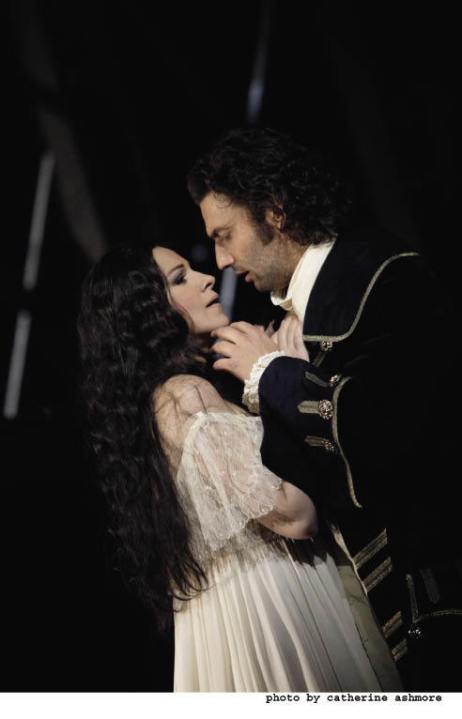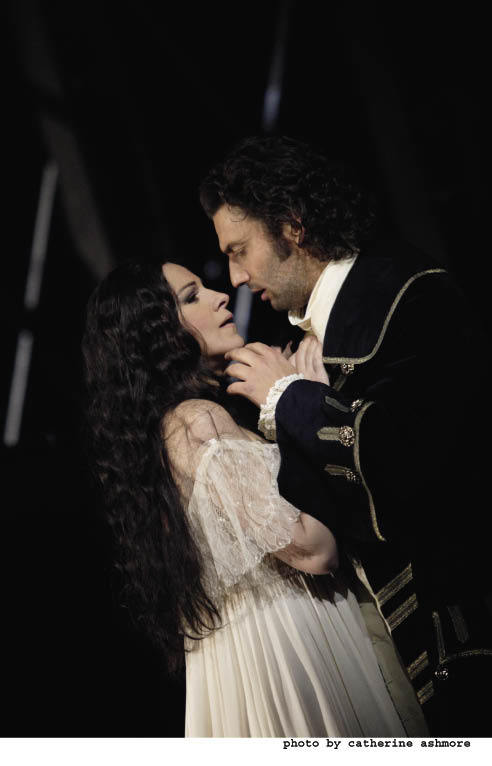Francesco Cilea’s Adriana Lecouvreur, his biggest success, dating from 1902, leads a fringe existence, but it persists thanks primarily to the name role, dramatically meaty and not imposing too great a strain on the performer.
Francesco Cilea’s Adriana Lecouvreur, his biggest success, dating from 1902, leads a fringe existence, but it persists thanks primarily to the name role, dramatically meaty and not imposing too great a strain on the performer. It has been mainly associated with singers at a fairly late stage — or thinking they were — of their career, Magda Olivero and Renata Tebaldi being the most notable. What is undeniable is that it is a vehicle, primarily for the prima donna, but to a lesser extent for her mezzo rival, the Princesse, and for the object of their affections, the tenor role of Maurizio Count of Saxony.
The Royal Opera’s programme book, for the first production there since 1906, doesn’t stint on pointing out that it is a theatrical work about theatre people, and the production itself doesn’t allow us to overlook that very obvious point either. It would hardly be worth mentioning if it weren’t for the distorting way in which this production makes the work end: the heroine has been sent violets by her rival, she kisses them, they are poisoned and she dies in the arms of Maurizio, after a moderately protracted aria in which she identifies herself with the Muse of Tragedy.
That takes place in this production behind the scenes at the Comédie Française (at Adriana’s house in the text), so the actors on the onstage stage walk to the back of it and applaud her death. That does seem to be taking things too far, and is the only emphatic piece of directorial intrusion by David McVicar. Otherwise the production, with elaborate set designs by Charles Edwards, which are going round Europe and to San Francisco, is a straightforwardly naturalistic affair, though it is sometimes inept, and often wildly hyperactive. The opening scene is a depiction of hectic backstage life just before a performance, but here Adriana doesn’t make an entrance, but is sitting in her chaotic dressing-room, so the combination of imperiousness and humility that should characterise her is undermined.
Angela Gheorghiu’s Adriana is, or anyway was on the first night, a disappointment. Her opening lines were so softly sung as to be almost inaudible, and for most of the opera she seemed to be feeling her way with care, so one had no sense of what I take to be the heart of the character, a great tragic actress whose life is out of control. In ensembles, especially the several love duets with Maurizio, she sang out more fully, presumably thanks to the confidence that Jonas Kaufmann, her Maurizio, radiates. He seems to ignite her whenever they perform together, and he is indeed an incandescent artist, in this case making a role which wouldn’t seem to offer much room for development into something interestingly complicated, Maurizio trying to find his way through the tangle of conflicting passions and political demands.
Her rival the Princesse was also very strongly taken by Michaela Schuster, though she, too, was hampered in Act II by the production, in which the rivals for Maurizio’s love fail to recognise one another: here it was inconceivable that they should fail, since they were singing virtually nose-to-nose. One is used to absurdities of this kind in Italian opera, especially in Verdi, but, again, there is a limit. The sad fourth main character, the stage manager who is futilely in love with Adriana, was brilliantly portrayed by Alessandro Corbelli.
The whole thing was evidently the product of immense pains, with Mark Elder conducting with such care that it might have been Pelléas. I often feel with these rumbustious early 20th-century so-miscalled verismo scores that something of the old-style Italian approach, which might seem slapdash but had abandon and urgency, would pay more rewards than this lavish devotion.
In Act III of Adriana there is a mock 18th-century ballet for the Judgment of Paris. A couple of nights later, I was in Bury St Edmunds, at the exquisite Theatre Royal, for Offenbach’s La belle Hélène, a drastically and refreshingly different setting of the same myth. I must admit that this production, by Suffolk Opera, surprised me very pleasantly. I was expecting a quasi-G & S account, with plenty of nudging political references and sexual innuendoes, and actor-singers behaving, speaking, as no human beings ever do.
Not at all: the acting was natural, the translation by Phil Park witty and relaxed, and Offenbach’s glorious score — though clearly it couldn’t be done justice by a pianist and a collection of mainly amateur singers but stiffened by some promising professionals — wasn’t hard done by. This wasn’t a complete version of the music, some of the most difficult numbers being omitted. But the Offenbachian spirit of irreverence, hedonism, effervescence and sensuous melodiousness survived. I look forward to future productions by this company; if they maintain this standard, opera-lovers will be travelling long distances to see them.







Comments